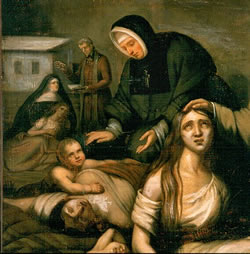Profiles & Stories
Irish Famine Orphan Profiles and Stories
 One of the recurrent and most striking images in the annals of the Grey Nuns and Sisters of Providence, as well as Théophile Hamel's painting Le Typhus (1847-1848), is that of the Sisters removing Irish infants from the breast of their stricken mothers. Hundreds of orphans were rescued from Montreal's fever sheds in 1847 and then adopted into French-Canadian and Irish families. As John Francis Maguire recounts in The Irish in America (1868):
One of the recurrent and most striking images in the annals of the Grey Nuns and Sisters of Providence, as well as Théophile Hamel's painting Le Typhus (1847-1848), is that of the Sisters removing Irish infants from the breast of their stricken mothers. Hundreds of orphans were rescued from Montreal's fever sheds in 1847 and then adopted into French-Canadian and Irish families. As John Francis Maguire recounts in The Irish in America (1868):
This deplorable havoc of human life left hundreds of orphans dependent on the compassion of the public; and nobly was the unconscious appeal of this multitude of destitute little ones responded to by the French Canadians. Half naked, squalid, covered with vermin generated by hunger, fever, and the foulness of the ship's hold, perhaps with the germs of the plague lurking in their vitiated blood, these helpless innocents of every age--from the infant taken from the bosom of its dead mother to the child that could barely tell the name of its parents--were gathered under the fostering protection of the Church. They were washed, and clad, and fed; and every effort was made by the clergy and nuns who took them into their charge to discover who they were, what their names, and which of them were related the one to the other, so that, if possible, children of the same family might not be separated for ever. A difficult thing it was to learn from mere infants whether, among more than 600 orphans, they had brothers or sisters. But by patiently observing the little creatures when they found strength and courage to play, their watchful protectors were enabled to find out relationships which, without such care, would have been otherwise unknown. If one infant ran to meet another, or caught its hand, or smiled at it, or kissed it, or showed pleasure in its society, here was a clue to be followed; and in many instances children of the same parents were thus preserved to each other. Many more, of course, were separated for ever, as these children were too young to tell their own names, or do anything save cry in piteous accents for 'mammy, mammy!' until soothed to slumber in the arms of a compassionate Sister...
Absorbed thus into the families of the French-speaking population, even the older Irish orphans soon lost almost every memory of their former home and of their parents, and grew up French Canadians in every respect save the more vigorous constitution for which they were indebted to nature. It is not, therefore, a rare thing to behold a tall, strapping, fair-skinned young fellow, with an unmistakable Irish name, and an unmistakable Irish face, who speaks and thinks as a French Canadian. Thus genuine Irish names--as Cassidy, or Lonergan, or Sullivan, or Quinn, or Murphy--are to be heard of at this day in many of the homes of the kindly habitans of Lower Canada…
The orphan children were gathered to the homes and hearts of the generous Canadians and the loving Irish; and most of them had grown up to manhood and womanhood before either monument or epitaph marked the spot in which the bones of their dead parents were mingling with the dust.
The digital Irish Famine Archive contains the profiles and stories of some of the most remarkable of these famine orphans who were adopted into French-Canadian families and went on to join the clergy, such as the siblings Patrick and Thomas Quinn and Daniel and Catherine Tighe from Denis Mahon's Strokestown Estate in County Roscommon, and Robert Walsh from Kilkenny.





